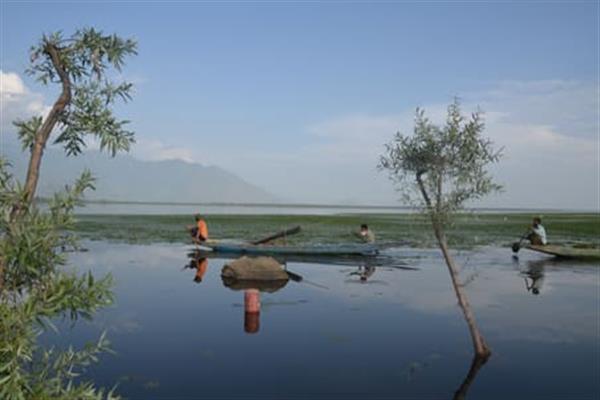Kashmir Magazine By : Kashmir Magazine | Srinagar, Publish Date: Sunday, July 15, 2018 2:15:39 PM | Updated Date : Sunday, July 15, 2018 2:15:39 PM

Learning no lesson from 2014 devastating floods, the government of Jammu and Kashmir for the last four years has not shown any interest to prepare itself for future floods. The initiative started four years back by the previous government has been left in midway and with the result; the constant rains during last three days have pushed the entire valley in flood threat.
The administration in J&K has sounded flood alert and even South and Central Kashmir have already been termed as flood hit and various low lying areas in South and central Kashmir are submerged in water.
Dredging and de-silting project
Though, post floods the Government of India had approved Rs 399 crore flood management plans for Jhelum to increase carrying capacity of the river and its flood spill channel and initially the government of J&K showed some seriousness and started a hugely funded project of dredging of Jhelum and desilting of flood channels. But later on, the project was moved at snail’s pace as the mechanical dredgers had been able to dredge only 1.4 lakh cubic metres (cum) of silt as against the overall target of 16 lakh cum.
The devastating floods of September 2014 had caused extensive siltation in river Jhelum thus drastically affected its carrying capacity. And right from the beginning, the project was delayed and it was only in November 2015 that the Government of India approved it. Ever since the commencing of the project the operation of machines and their operating company has been in the news for all the bad reasons. Frequent breakdown of machines, selection dredging spots according to their ease and non-availability of desired results have been plaguing the dredging project.
Court direction
The floods not only affect the populated areas but are disastrous for water bodies and wetlands. As per the experts, “over 90 per cent of the wetlands are facing problems because of the blockage of their inputs and. Wetlands are being occupied by people for construction purposes and even at many places government buildings are too constructed on wetlands,’ said an environmental expert. As per reports, 40 per cent of Wular Lake is destroyed and 50 per cent of wetlands are gone. Mirgund is 70 per cent gone. Manasbal Lake, which is the deepest lake in the Kashmir wetland ecosystem, has suffered huge loss and has stopped oozing of fresh water.
Pertinently, the J&K high court in 2017 in response to a Public Interest Litigation PIL to protect the water bodies directed the concerned authorities for the conservation of water bodies and wetlands in the valley. To protect various water bodies, along with river Jhelum, High Court directed the then government to demarcate the wetlands and take measures to conserve water bodies in the Valley. In response to PIL, HC headed by Justice Badar Durrez Ahmed and Ali Mohammad Magrey in 2017 ordered immediate demarcation of wildlife forests, wildlife sanctuaries and conservation reserves by the concerned authority.
The then Commissioner Secretary Forest was asked to act as nodal authority to ensure that demarcation is carried out with Geographic Information System (GIS) technology.
To build interconnections between wetlands and rivers, the court ordered Commissioner Secretary Irrigation Department to convene a meeting and submit an action plan on next hearing in September 2017. “Though High Court J&K seemed concerned to protest the priceless water bodies and wetlands of the valley, but the directions lost their effect with the passage of time,” said Wali Mohammad a resident of Manasbal.
Future strategy
Experts say that dredging of river Jhelum and desilting of flood channels is not enough to avert the future floods because the carrying capacity of Wular which is the final destination for Jhelum and other bodies has decreased to much extent. After 2014 floods no desilting or dredging has been done in Wular Lake which is a real concern and has become the main reason for the swell up of Jhelum River.
Irrigation expert and ex-Chief Irrigation and Flood Control, ErImtiyazDhar said, “Until Walur Lake and wetlands like Hokersar and Ancharlake will not be de-silted nothing will happen on the ground.”
Dhar further said that “When I was heading the I&FC department, we recommend dredging of Walur Lake but unfortunately the Lake is under the control of forest department, so the Irrigation Department couldn’t intervene into it,” adding “If the government is serious about the flood they have to dredge Wular Lake and Wetlands like Anchar and Hokarsar.”
Official Version
Seeing the alarming situation of Jhelum and other water bodies the concerned authorities and government administration announced the emergency. According to Divisional Commissioner Kashmir, Baseer Ahmad Khan, the government has taken every possible step to avert the flood situation in Srinagar and other vulnerable districts. “We are on our toes and we have alerted every person of the concerned department’s including disaster management, police and irrigation and flood control department to deal with any untoward situation.”
When asked about the failure of the dredging project, Khan said, “The government has not taken any leniency in dredging project. So far if we are safe and the Jhelum has not overflowed is a proof of proper dredging in Jhelum and other flood channels.”